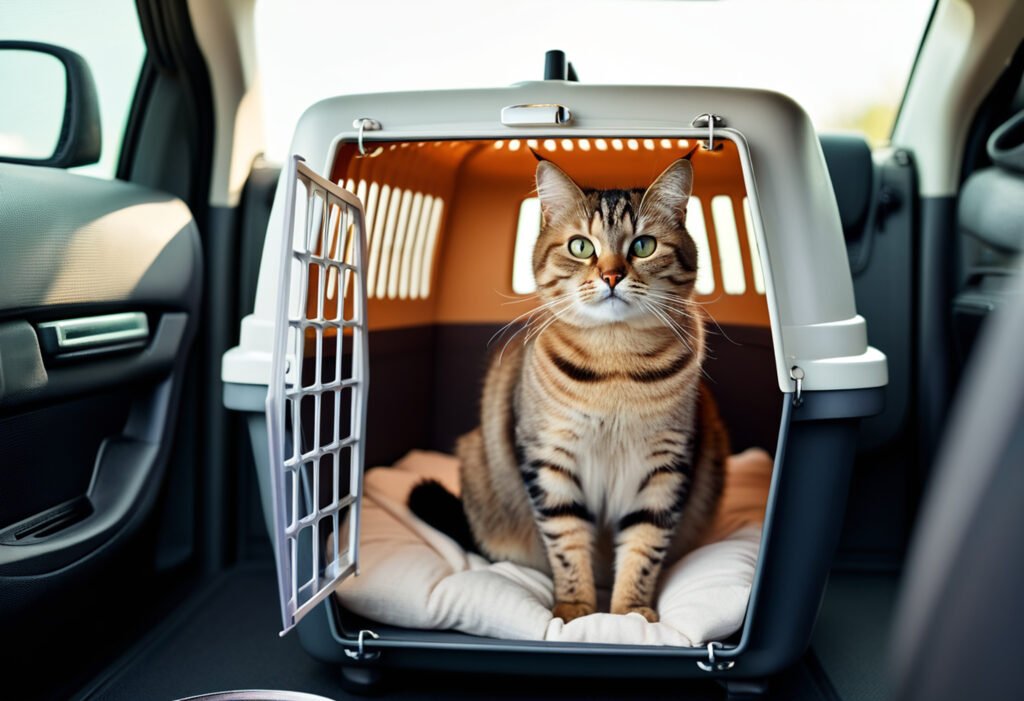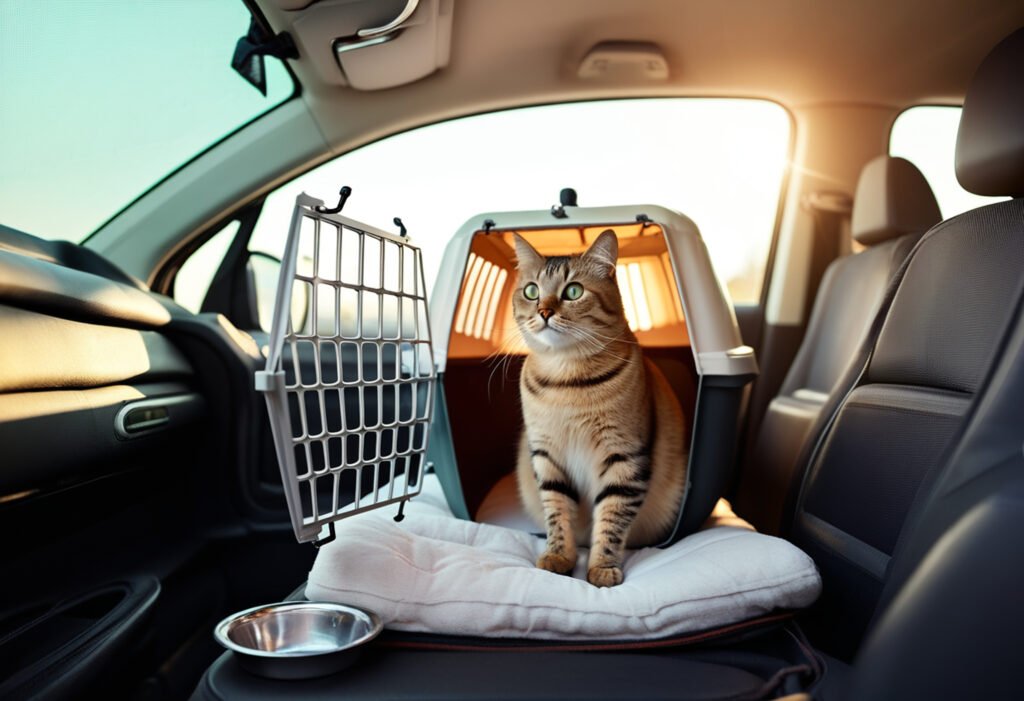Moving a cat across country ranks among the toughest parts of changing homes. A move brings excitement but also creates stress and drains you physically, especially when you’re going far. Being a cat parent, I know our furry friends are family members who just need extra care during big changes.
Over 90 million American households have at least one pet. Texas pet owners treat their pets like family, and getting them settled matters as much as the move itself. You’re not alone if you wonder about moving cats across country or traveling with them by car. Success comes from solid planning when you move long-distance with pets. This piece walks you through everything you should know to get your cat safely and comfortably to your new home.
Planning for a Cross-Country Cat Move
Moving a cat across the country needs careful planning that should start weeks before you leave. Good preparation will make this experience less stressful for you and your cat.
Visit your vet and get health records
A pre-travel vet visit should be your first step. Your vet will tell you what papers you need based on where you’re going. Most airlines want a health certificate issued within 10 days of travel. You’ll need updated vaccination records even for road trips since requirements differ between states.
This visit is a chance to talk about ways to keep your cat calm during travel. Vets usually avoid sedatives but can suggest pheromone sprays that help reduce anxiety. Your cat’s health documents work like a passport, so keep the originals with you throughout the trip.
Update microchip and ID tags
A microchip won’t help if it doesn’t have your current contact details. Pet911’s largest longitudinal study shows over 1.7 million pets went missing from their homes in 2024 in the U.S. alone. Check if your cat’s microchip works properly and update the registry with your new address and phone number before you travel.
A temporary ID tag with your destination address and current mobile number serves as backup identification. This small step could reunite you with your pet if they get lost during the move.
Research pet-friendly stops and hotels
Look for places that welcome cats specifically, not just dogs. Days Inn, Extended Stay America, Hotels by Hilton, Marriott Hotels, Motel 6, and Red Roof Inns are cat-friendly hotel chains. Trying to sneak your cat into hotels that don’t allow pets is never a good idea.
Pet stores make better rest stops since you can take cats inside instead of leaving them in the car. Your route should include pet relief areas you can reach every few hours.
Understand airline or car travel rules
Airlines have their own rules about pet transport. Some let cats ride in-cabin while others require cargo transport. International travel can get complicated – some countries ban pets completely, while others have strict rules about vaccinations.
Cats need secure carriers while driving. The car’s temperature can be dangerous, so never leave your cat alone in it. Pack a small litter box with disposable liners for bathroom breaks.
Packing Essentials for a Safe Journey

The right packing strategy is the lifeblood of a smooth experience when you move your cat across the country. You’ll need the right supplies to avoid stress and problems along the way.
Create a cat travel kit
A dedicated cat travel kit makes pet care much easier during long trips. Think of this kit as your one-stop collection for everything your cat needs. Put this kit together at least a week before you leave to make sure you have everything. Keep these items in a separate bag from your stuff so you can grab them quickly during stops or emergencies.
Include food, water, and medications
Your cat needs consistent food during car travel. Kibble tends to be more travel-friendly than wet food because it stays fresh longer. Collapsible silicone bowls work great for water during road trips. Make sure you pack at least a week’s worth of any medications your cat needs to keep taking.
Your vet can help if your cat gets anxious during travel. FDA-approved medications like Bonqat (containing pregabalin) can help when given about 1.5 hours before the trip. You could also try synthetic pheromone sprays that calm without a prescription.
Use a secure and comfortable carrier
Your cat’s carrier becomes their safe space during the trip. Soft-sided carriers tend to perform better in the Center for Pet Safety crash testing. Look for carriers with:
- Zipper locks to prevent escapes
- Machine-washable shells for easy cleaning after accidents
- Adequate ventilation and visibility
Pack familiar items like toys or blankets
Comfort items from home help reduce stress during long-distance cat travel. Put your old shirt or their favorite blanket in the carrier. These items with familiar smells help your cat feel secure in new places. Pack one or two favorite toys for rest stops, but don’t overwhelm your cat with too many choices.
Keeping Your Cat Calm and Safe During Travel
Taking your cat on a long-distance trip comes with its own set of challenges. Your cat’s experience depends on how well you prepare and handle the actual travel.
Practice crate time before the move
Your cat needs time to get used to their carrier well before moving day. Put the carrier in a common area with its door open at least several weeks ahead. Add familiar bedding, toys, and treats inside to make it welcoming. Start with short periods of door closure and slowly work up to longer times. Long trips might need a bigger carrier so your cat can move around comfortably.
Avoid feeding right before departure
Stop feeding your cat 4-5 hours before travel to help prevent motion sickness. All the same, keep water available until you leave and during stops on your trip. Special bowls that attach to carriers work great for longer trips – you can refill them without opening the door.
Use calming sprays or vet-approved aids
You have several options to help reduce your cat’s anxiety:
- Pheromone sprays on carrier bedding (wait 15-20 minutes for the alcohol smell to fade)
- Calming collars that release synthetic pheromones
- Vet-prescribed medications like Bonqat or mild sedatives for severe anxiety
- Natural supplements containing L-theanine or melatonin
Ensure proper ventilation and hydration
Good airflow matters throughout your trip. Place the carrier where it gets enough air but stays secure if you need to brake suddenly. Check on your cat often, especially in warm weather. Ice packs wrapped and placed around the carrier (not inside) help keep temperatures comfortable in hot weather.
Never leave your cat alone in the car
Cars heat up quickly and can become deadly. Heat stroke kills cats fast. Someone should always stay with your cat during stops, keeping doors or windows open for air. If you absolutely must leave briefly, cool the car down first and hurry back.
Helping Your Cat Adjust to the New Home

The last vital step after reaching your new home is to help your cats settle into their new environment comfortable adjustment period. Your furry friend needs time to get used to the new surroundings at their own pace.
Set up a quiet room first
You should set up a dedicated room with everything your cat needs before letting them explore the whole house. The room needs food, water bowls, a litter box, cozy bedding, favorite toys, and a scratching post. Your cat will feel more secure in this smaller space instead of getting overwhelmed by too many new things at once.
Stick to familiar routines
Your cat’s daily schedule should stay the same for feeding, playtime, and other activities. Small, frequent meals will help your cat feel more secure in the new space. On top of that, you can make the house feel more familiar by spreading your cat’s scent with a soft cloth rubbed on their cheeks.
Gradually introduce new spaces
Let your cat explore more areas once they seem comfortable in their safe room. Keep the door slightly open so they can check things out when ready. You should give them access to one area at a time rather than opening up the entire house at once.
Monitor behavior and stress signals
Look for signs that show your cat is adjusting well – like exploring, wanting attention, eating normally, and regular grooming. Your cat might need a vet visit if they hide for long periods, lose their appetite, or stop using the litter box. Keep your cats inside for at least two weeks while they get used to their new home.
Conclusion
Moving a cat across country needs careful planning, but you’ll find it’s worth the effort when your cat feels at home. Patience becomes your best friend during this trip. Each cat adapts differently – some will check out their new space within hours, while others might take weeks to feel comfortable.
Cats love their routines and familiar spaces. The steps in this piece will help reduce stress a lot for both you and your cat during such a big change. Your cat picks up on your emotions easily, so staying calm helps them feel safe and secure.
Many cats handle long-distance moves better than expected if you plan well. I learned this firsthand when moving with my two cats. A well-laid-out strategy made everything easier. My original worries faded away as I focused on careful planning, proper packing, stress management during travel, and a step-by-step introduction to our new home.
Without doubt, this shared experience will make your bond even stronger. Your new place will soon feel like home, with fresh spots where your cat can nap, play, and make memories with you. Your steadfast dedication during this time shows how much you care – something your cat will appreciate in their own special way.

